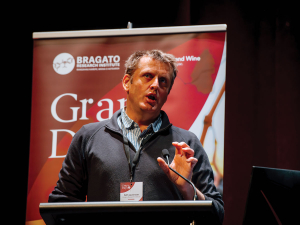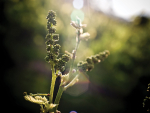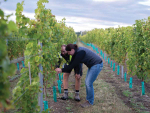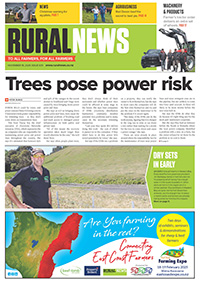The Bragato Research Institute Sustainability Research Leader spoke to Grape Days attendees about the development of a carbon calculator to help growers and wine companies make informed decisions on vineyard practices and purchasing priorities. "Essentially improving energy efficiency, moving away from diesel, and decarbonising with electricity as well."
During the next 12 months the programme, which is being run with the Marlborough Circular Wine Group, hopes to recruit 100 growers to use the calculator (currently in app form) to gather data about carbon emissions from vineyard activities. A grower could, for example, enter the diesel use of a specific tractor running a trimmer across a certain number of rows. "What we essentially want to do is to build a database that other growers can use around the carbon spend of that one tractor pass," Seth said.
As well as helping growers make informed decisions in machinery purchases and use, the data will also help inform the wine industry about potential electrification of tasks, and the subsequent power requirements. "For instance, if there's a widespread shift to electrification across Marlborough, we would need a 250% increase in the amount of electricity we have, which is not realistic. One of the key parts of this is to work with our colleagues at Marlborough Lines to understand that shift."
Seth front-footed the oft asked question of why soil and vine carbon capture are not included in carbon accounting, emphasising that those stocks are highly labile, shifting between seasons and years. There are voluntary systems that do account for those stocks, but they are very expensive due to the need to repeatedly, he said.
Meagan Littlejohn, New Zealand Winegrowers Programme Manager for Sustainable Winegrowing New Zealand told attendees that vineyard activities were responsible for 17% of New Zealand wine industry emissions, with 56% of the vineyard footprint from diesel use.
Giving an overview of NZW’s Roadmap to Net Zero 2050, which outlines key milestones and emission-reduction opportunities in vineyards and wineries, she emphasised the increasing demand in global markets for proof of sustainable practices. “They’re asking for more information and more evidence to back up any claims that you’re making.” About 80% of all New Zealand wine exports are now going to markets that have mandatory climate-related disclosures in place, and a growing portion are also going to markets that have mandatory or proposed carbon border adjustment mechanisms. Emissions reporting and reduction are becoming market access issues, Meagan said. “Or an opportunity if you can meet all of their requirements.”
Read More:
Grape Days - C the Light
The use of UV-C light in vineyards could halve fungicides applications for powdery mildew, according to results from the first season of a two-year trial in Marlborough. Bragato Research Institute Viticulture Research Scientist Dr Paul Epee told Grape Days attendees that the project, being run by BRI in partnership with A Lighter Touch, Whitehaven Wines and Agri-automation, already had “positive and exciting” results.
UV-C light (type C ultraviolet light) technology was being tested and used internationally as a cost effective and environmentally friendlier option for controlling grapevine powdery mildew.
The trial being run at a Whitehaven vineyard block in Rapaura involved an autonomous robot carrying a machine emitting UV-C radiations. The robot operates at night, when the pathogen is more vulnerable and unable to repair the damage caused.
“In a nutshell, the trial is showing that UV-C light can control powdery mildew up until pre-bunch closure on leaves and in bunches. And the combination of UV-C light with fungicides – either at three key points in the growing season, or with very light or low environmental impact fungicides like sulphur – can make a big difference and cut down the amount of fungicide by half or more.”
According to Paul’s presentation at Grape Days 2025, the increased use of fungicides for powdery mildew – estimated at more than 1,900 tonnes annually – endangers the environment and vineyard biodiversity, killing both powdery mildew and beneficial fungi, especially when broad-spectrum fungicides are applied.
Growers are also at risk of reduced efficacy of fungicides and resistance development issues when the same active ingredient is used repeatedly, Paul said. “Therefore, this project offers a non-chemical, more sustainable alternative to divest from synthetic fungicides for the control of powdery mildew in New Zealand vineyards.”
Probing Questions
Growers using soil moisture sensors without calibrating for block specifics could be watering far too much or too little, says an irrigation expert. Speaking at Grape Days events around New Zealand in June, Dr Mark Krasnow presented results from trials with the Marlborough Grape Growers Cooperative, in conjunction with his consultancy, Thoughtful Viticulture, and Dr Stewart Field of Nelson Marlborough Institute of Technology. “You can be overwatering or underwatering your vines pretty badly by just blindly looking at soil moisture graphs and trying to keep them in the green zone,” Mark said.
“Many people don’t go any further than installing the probes, which have a pre-set ‘refill point’ and ‘stress point’, based on soil type and grower risk tolerance, and then just try to irrigate to those points.” But depending on where the vines’ roots are relative to the probe depth, the pre-set stress point can be dramatically wrong, he said. “To the point where you are costing yourself money by losing yield if they underestimate actual vine stress, or you are costing yourself money by putting on too much water because they overestimate vine stress. By actually measuring the vines, the precise stress point can be determined and the red line moved there on the soil moisture graph”.












